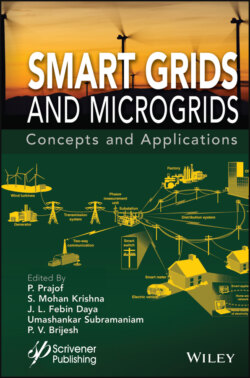Читать книгу Smart Grids and Micro-Grids - Umashankar Subramaniam - Страница 33
2.2 Need of ESS (Energy Storage Systems)
ОглавлениеThe power management of renewable energy source based microgrid is complicated by virtue of the intermittencies and unpredictability issues of renewable distributed generators. The flexibility in a microgrid can be established with Energy Storage Systems (ESS) having the ability to operate as a load or generator, which can eventually balance the fluctuation in the microgrid and significantly improves the microgrid stability. Depending on the requirement of the microgrid, ESS is required to fulfil the objectives of maintaining grid reliability with reduced microgrid operation costs. Some of the function that may be required to be performed by ESS is listed as follows:
1. Load-levelling and Peak-shifting: The renewable systems produce energy only during the availability of the natural source regardless of the demand during peak hour. Thus, this difference in energy may lead to power overflow and losses. This energy gap can be moved by using ESS (Energy Storage Systems) to meet the peak demand and level the load curve. The other way for levelling the load curve is to instruct the consumers on energy efficiency, demand response programs, cost of the microgrid operation and energy utilization and management using ESS. This approach favours to utilities in generation expenses, line loss reduction, and volt support [1].
2. Power Quality Support: The ESS can support the microgrid or main grid for power quality improvements such as low-voltage ride through (LVRT) and voltage regulation. The capability of generators to stay operative under voltage sag conditions without getting disconnected from the grid is known as low-voltage ride-through (LVRT). The implementation of ESS can substantially improve the low-voltage ride-through of the generator. Moreover, The ESS can also be used to improve the voltage regulation because of its rapid voltage support.
3. Smart Grid: Smart grids are turning into a noticeable option for efficient energy transmission and distribution from multiple power supplies. ESS in a smart grid ensures the reliability of energy supplied to the consumers. It also includes upcoming prosumers such as smart houses and electric vehicles as major contributors of grids to avoid network over-loads by regulating and controlling the inconsistent power [2].
4. Electric Vehicles: Plugin and hybrid Electric vehicles are becoming prevalent and attracting recent research. Recent research in battery management system (BMS), drives and battery are promoting electric vehicles (EV) at a fast pace and with drop in cost of ESS. The ESS of the EV (Electric Vehicles) can also feedback the power to the grid under appropriate planning and scheduling. More than one type of batteries can also be coupled together in the form of hybrid ESS to deliver the required energy [3].
5. Smart Homes: ESS is an integral part of energy sustainable buildings and smart homes. An associated smart energy management system can efficiently manage energy storage and power utilization. The accurate data of consumption and subsequent emissions can also be provided. Smart homes efficiently use the energy with lesser emission.
6. Uninterruptible Power Supply (UPS): UPS is the significant application of ESSs in microgrids, particularly for the islanded microgrids. Renewable energy sources, such as solar photovoltaic and wind turbines, may unexpectedly stop producing power because of clouds, nightfall or lack of wind. However, turning on the backup generators may take few seconds [4]. To avoid the chances of outages in the microgrid during this period the ESS in the microgrid rides through the power shortage.
